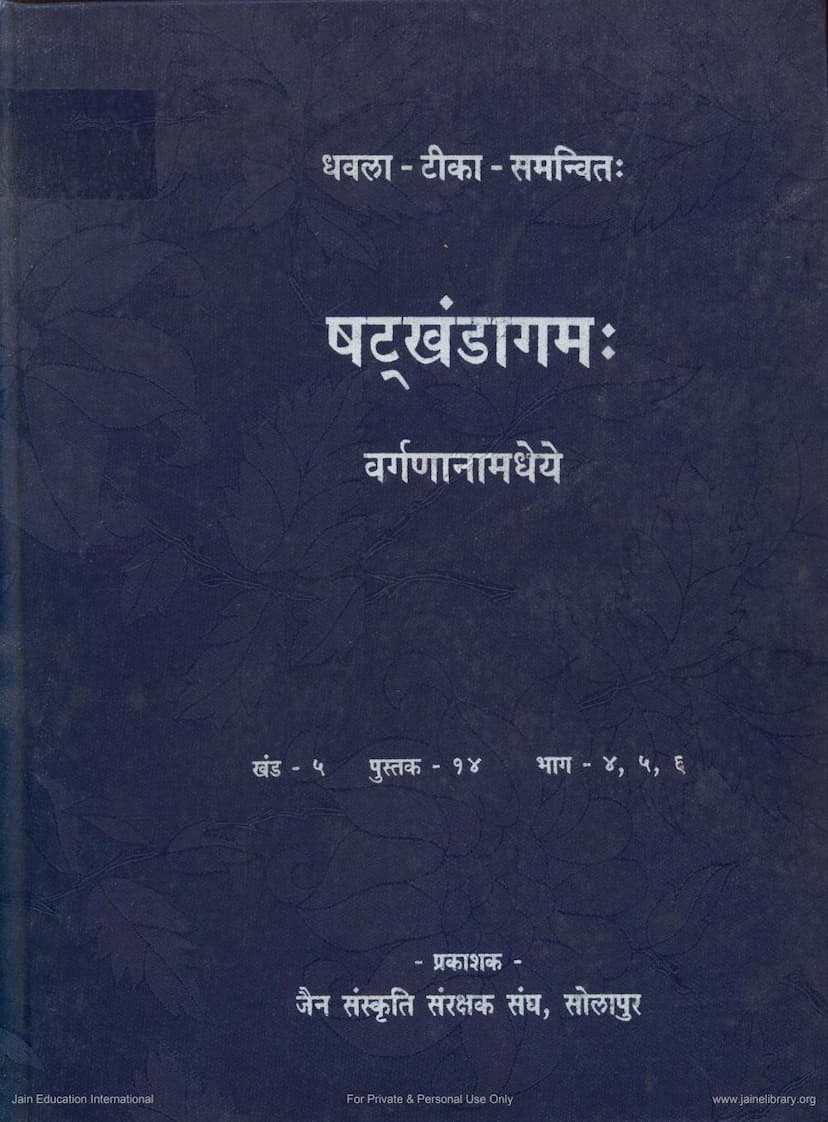Shatkhandagama Pustak 14
Added to library: September 2, 2025

Summary
This book, "Shatkhandagama Pustak 14," is part of a larger Jain text, the Shatkhandagama, with the commentary Dhavala by Virasena. This particular volume, Book 14, is the fifth volume of the Vargana section and focuses on the "Bandhananayogadwaram" (Chapter on Binding). It was published in 1994 by Jain Sanskriti Samrakshak Sangh, Solapur, and is the revised second edition.
Here's a summary of the content based on the provided text and table of contents:
Overall Theme:
The book delves into the concept of "bandhana" (binding) within Jain philosophy, specifically analyzing its different aspects through the lens of "anuyogadwaras" (analytic subdivisions of principles). A significant portion of the text is dedicated to the detailed examination of "varganas," which are classifications or groupings of substances or entities.
Key Concepts and Structure:
The text appears to be structured around four primary aspects of binding:
- Bandha (Bond): The act or state of being bound.
- Bandhaka (Binder): The entity that causes the binding.
- Bandhaniya (Thing to be Bound): The entity that is bound.
- Bandhavidhana (Method of Binding): The process or rules of binding.
The book focuses primarily on Bandha and Bandhaniya, with brief mentions of Bandhaka and Bandhavidhana as their detailed explanations are found elsewhere (in Khuddabandha and Mahabandha respectively).
Detailed Summary of Chapters/Sections:
The book is divided into several sections, each exploring the concepts from different perspectives and through various analytical tools:
- Introduction of the Granthamala (Book Series): The Jeevraj Jain Granthamala is introduced, highlighting its establishment and the generous contribution of Shri Brahmachari Jeevraj Gautamchand Doshi.
- Vargana Khanda (Section on Varganas): This is the core of the book. It thoroughly investigates "varganas" (classifications/groupings).
- Bandhananayogadwaram (Chapter on Binding): This chapter initiates the discussion on binding, defining its four aspects: Bandha, Bandhaka, Bandhaniya, and Bandhavidhana.
- Bandha: Four types of bondage are discussed: Namabandha (nominal binding), Sthapanabandha (representational binding), Dravya-bandha (material binding), and Bhavabandha (psychic binding). The text elaborates on the acceptance of these by different Nayas (perspectives like Naigama, Vyavahara, Shabda, etc.) and provides detailed explanations of the subtypes of Dravya-bandha and Bhava-bandha (including the distinction between Vipaakaj, Avipaakaj, and Tadubhaya types for both Jeeva and Ajiva).
- Bandhaniya (The Bound Entity): This section focuses on the "varganas" themselves as the entities to be bound. The text explains that these are the karmic and non-karmic subtle matter (pudgala) collections that are subject to experience. The process involves analyzing "varganas" through eight "anuyogadwaras": Vargana, Vargana-dravya-samudaya, Anantaropnida, Paramroopnida, Avahara, Yavmadhya, Padmimamsa, and Alpabahutva.
- Vargana (Classification): Varganas are divided into two main types: Abhyantara Vargana (internal varganas) and Bahya Vargana (external varganas).
- Abhyantara Vargana: Further divided into Ekashreni (single line/sequence) and Nanashreni (multiple lines/sequences). The text then details the sixteen anuyogadwaras that analyze Ekashreni Varganas (Vargananikshepa, Naya Vibhashanta, Vargana-praroopana, Vargana-nirupana, etc.). A significant portion discusses the twenty-three types of varganas, including those related to atoms, body substances (Tejas, Karman), language, mind, etc., and their characteristics, such as Dhruvaskandha (permanent clusters) and Dhruvashunya (permanent void). It also details types like Badar Nigoda and Sukshma Nigoda varganas.
- Bahya Vargana: These are analyzed through four anuyogadwaras: Shariri-Shariraprrupana (discussion of embodied and embodiment), Sharira-prrupana (discussion of bodies), Sharira-visrasopachaya-prrupana (discussion of bodies' visrasopachaya), and Visrasopachaya-prrupana (discussion of visrasopachaya). This section discusses the concept of bodies (Sharira) and the embodied beings (Shariri), detailing the five types of bodies (Audarika, Vaikriyika, Aharaka, Taijasa, and Karmana) and their characteristics.
- Vargana (Classification): Varganas are divided into two main types: Abhyantara Vargana (internal varganas) and Bahya Vargana (external varganas).
- Choolika (Explanations/Appendices): This section provides further explanations and details on the topics previously discussed, particularly elaborating on specific concepts like the process of generation and demise of Nigoda beings and the classification of varganas.
- Bandhananuyogadwaram (Chapter on Binding): This chapter, as mentioned, provides a foundational discussion on the four aspects of binding (Bandha, Bandhaka, Bandhaniya, Bandhavidhana) and then proceeds to analyze Bandha in detail, categorizing it into Nama, Sthapana, Dravya, and Bhava bandhas, with extensive sub-classifications and explanations. The role of Nayas (philosophical viewpoints) in understanding these bands is also discussed.
- Bandhak (Binder): Briefly mentioned as special consideration in Khuddabandha.
- Bandhaniya (The Bound Entity): This section extensively discusses Varganas, their generation, characteristics, and classifications using the eight anuyogadwaras mentioned earlier.
- Bandhavidhana (Method of Binding): Briefly mentioned as detailed in Mahabandha.
- Bandhananayogadwaram (Chapter on Binding): This chapter initiates the discussion on binding, defining its four aspects: Bandha, Bandhaka, Bandhaniya, and Bandhavidhana.
- Appendices: The book includes various appendices such as Sutra in original (Sutta), list of Gathas, list of special sentences, Nyaya utterances, Granthollekha (references to other texts), and a glossary of technical terms.
Editorial and Publication Details:
- Editors: Late Dr. Hiralal Jain (Chief Editor), Late Pt. Phoolchandra Siddhanta Shastri, Late Pt. Balachandra Siddhanta Shastri.
- Research Assistants: Late Dr. A. N. Upadhye, Late Dr. Pt. Ratanchandji Mukhtar, Pt. Jawaharlal Jain Shastri.
- Granthamala Editors: Pt. Narendrakumar Bhisikar Shastri, Dr. Pt. Devendrakumar Shastri.
- Publisher: Jaina Samskriti Samrakshaka Sangha, Solapur.
- Year of Publication: 1994 AD / 2520 Veera Nirvana Samvat.
- Edition: Revised Second Edition.
In essence, Book 14 of Shatkhandagama, with the Dhavala commentary, is a profound and meticulously detailed exploration of the Jain concepts of binding and varganas, offering a deep dive into the intricate philosophical and cosmological framework of Jainism. The text aims to provide a comprehensive understanding of these concepts, supported by rigorous analysis through various scriptural methods.